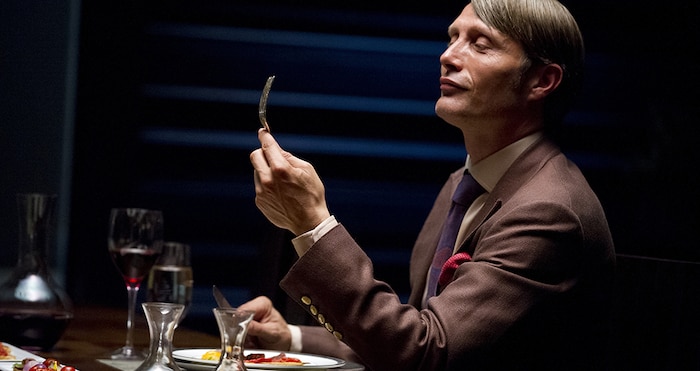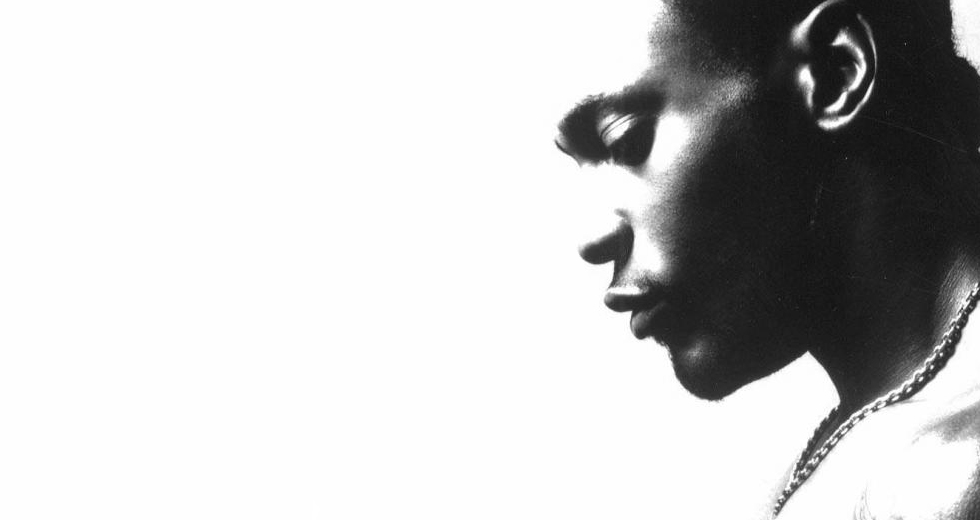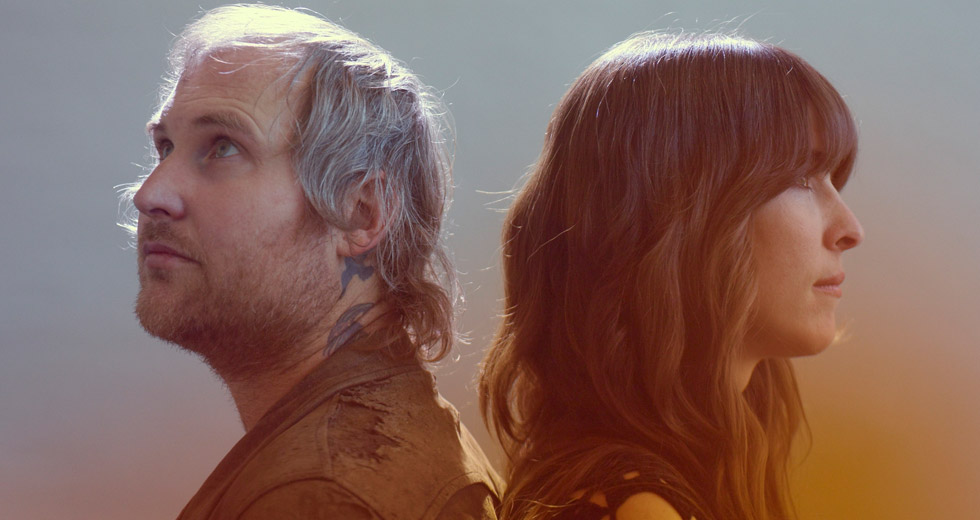Interview: Brian Reitzell on Hannibal, Kevin Shields, and Japanese Soundtracks

With Hannibal, Brian Reitzell has created one of the most unsettling scores for a TV show ever. It goes well with the subject matter, which – as the title suggests – is a reimagining of the Hannibal Lecter story. Few people would have guessed that this often visualized tale needed another version. But between Mads Mikkelsen’s chilly Nordic take on Lecter, executive producer Bryan Fuller’s artistic vision that transforms horrible crimes into Baroque art pieces, and Reitzell’s phenomenal score, the show has quickly justified its existence.
Reitzell’s path to Hannibal is a unique one. Starting out in the indie rock group Redd Kross, he’s made his way through the movie business – working most notably with Sofia Coppola over the years on Lost in Translation and The Bling Ring. And he’s also continued to make music under his own name. Auto Music, an album of originals, will be released in June on Smalltown Supersound. In advance of the season finale of Hannibal, we recently took the opportunity to talk to Reitzell about why the sound of bronze is so special, the influence of Kevin Shields on his work and more.
One of the things you’ve said about the work that you’ve done relating to Hannibal is that the sound of bronze is quite special. I was wondering if you could talk a little bit about that.
I’ve been a drummer/percussionist my whole life, for as long as I can remember. So I’ve been hitting on pieces of metal for a long time. I would break cymbals every night back when I’d play drums with Redd Kross. I started as time went on to develop quite a sense for cymbals. More so than drums. Drums are quite malleable. I mean, they’re drums. It’s a plastic head and a wood shell.
But cymbals, they can sound real tinny or they can sound very musical. I certainly have some prize cymbals, one of which is a Zildjian cymbal that used to belong to Paul Humphrey, who was this incredible studio/jazz drummer. Played with Mingus, Dusty Springfield, etc.
Do they sound better with age?
I’ve noticed that bronze creates the most complex waveforms known to man.
They do. Honestly, in my experience, all musical instruments sound better with age. Wood sounds better. Metal sounds better. About six or seven years ago, I went on a trip to Kyoto, Japan, for a week and then Bali. And going to Bali was a real ear opener for me. I’ve always loved gamelan music. It’s one of the reasons I actually wanted to go down there anyway. Like when you go to Jamaica, you hear reggae music everywhere you go. When you go to Bali, you are constantly hearing the sounds of gamelan.
I went to the side of the island where they make most of the gamelan instruments, these gong factories where they used to make instruments for the royal family or whatever it was. I went and hung out there for the better part of a day, and picked out a whole set of gamelan instruments which I brought back and have been playing and experimenting with ever since. In doing my research, I’ve noticed that bronze creates the most complex waveforms known to man.
There’s a thing called a ceng ceng. They’re like these little bronze cymbals and you hold two in each hand. They sort of cup around your fingers. Then there’s a turtle, this wood engraved turtle that’s painted gold and red. (Everything’s gold and red, by the way.) And then it’s got a bunch of these cymbals, probably about ten of them, nailed to it upside down. So you sort of play on top of it. It’s just the loudest clamorous instrument ever, and I love it. Then there’s this other instrument that looks maybe like a little xylophone. You play it with this hammer that is just one of the most violent looking things you could imagine. It looks like something you just want to kill someone with.
So, quite useful for Hannibal scoring.
It is. I play it in a way that you’re not really supposed to play it. Because what you do is when you hit one – before you hit the next one, you mute the previous one so that they never overhang. Because it creates such dissonance of the two waveforms rubbing against each other that it literally splits your skull open. But it does it in a way that is so magnificently crystalline. It’s like staring at the sun. I like to use those textures quite a bit.
To take it one step further ... I told you I went to Kyoto. I’m a big fan of Toru Takemitsu. In watching a documentary on Takemitsu, I noticed a percussionist playing what looked to me like a bronze slit drum. A slit drum is an African tongue drum. This was made out of bronze. I found a guy to make me one. Which took well over a year. Bronze is $20 a pound, and the drum is thirty pounds.
It literally splits your skull open. But it does it in a way that is so magnificently crystalline.
That drum, I use for Hannibal. Especially for the Hannibal character, when he’s onscreen. It sounds like nothing else. It’s just such an interesting, rich tone color. And I speed it up. I slow it down. I do all kinds of things to it. But we mostly play it. It doesn’t work so well for me on a timpani. I prefer playing it on top of a 40-inch Leedy bass drum. That’s like my resonator. So I set it on top of the drum, and away we go.
When did you first become aware of Takemitsu and his work?
In this season of Hannibal each episode is named after a Japanese food course. It kind of gave me the opportunity to exploit my deep affection with Japanese films. I’m a huge fan of Ozu and Hiroshi Teshigahara and all those guys. But there’s something really special about Takemitsu’s work for me. I’ve got a book that lists everything he ever did, and I’m listening to concert work, film work, television work. They’re all good.
I personally learned about Takemitsu when I was in Japan on tour with Redd Kross. At the time, I was obsessed with collecting Art Blakey be-bop records, especially his drum records. Holiday for Skins, The African Beat, and Orgy in Rhythm. I bought a Takemitsu record, and had no idea who he was. I listened to it when I got home, and I liked it and just kind of set it aside. Then I saw The Woman in the Dunes, and it just freaked me out. If I had to pick one film, it would probably be that one. The score is just so good.
Do you remember when you first became aware of sound as design? Because I think it’s an interesting kind of distinction. To make that jump from music as “music” to thinking about it in this different way.
I think I pretty much always thought of music as a textural thing. My earliest memories find me literally on the floor in my garage lying on a stack of dirty clothes listening to the dryer spin. The sound of the dryer was so comforting to me. I loved it. I would lie in the dark garage and just sleep.
Also, just sound. My father had a flat bottom drag boat. He used to start the engine up. I lived in the suburbs at the time. All the kids in the block would run over because it just sounded like an explosion. Those sounds were very thrilling and interesting to me.
With Hannibal, I don’t really think of it as sound design. I think of it as music because I’m not using the kind of tricks that a sound designer would use. I’m not doing a lot of far out stuff. What I’m doing is a lot of percussion. Almost everything that I do with that show is musical.
You’ve said in the past that each episode has like 40 minutes of score or so in a 43-minute episode. That’s a lot for a normal television show.
Yeah. I come from the world of film. My favorite film scores, like the Takemitsu scores, have very little music. I think one of the biggest problems with television music – and why I was never interested in it – is because the music is so manipulative. It’s telling you constantly how to feel. And I don’t like that.
Scientists will tell you that the Japanese listened to music differently than any other culture.
But with Hannibal, it’s a completely different trip. I find that given the nature of the show... Bryan Fuller, who is the executive producer on the show, says that he wants to be constantly cocooned by the music. So the music, it’s a bath. It’s always on. Some episodes have over 43 minutes of music. It’s almost the whole show. I’ve tried to not do that, and it just doesn’t feel right. Then I watch shows like True Detective, and say, “How do these people get away with it?” When I watched that show, I’m just thinking the whole time, “Why is nobody adding this level, this texture that this show really kind of needs?”
I never thought I would be doing that much music. I’ve definitely backed myself into a hole because I have to kick out 40 minutes of music in a week. And everything’s played. I have a full-time engineer, so we’re moving mics and we’re tearing things down and we’re setting things up constantly. I’m not sitting in front of a laptop during this stuff. It’s all played. It’s a brutal job.
Is a lot of it instinctive, though?
All of it. It’s totally reactive. I think with horror music, that is crucial. What I like to do is get my first gut response. I don’t read scripts. I don’t want to be ahead. I don’t want to know where things are headed. What I will do is sit down, and the very first time I watch it, I will play an instrument. I’ll go through the whole show. Sometimes I’ll sit at a drum kit and just play whatever. I’ll play right along with the whole thing. I think the show has a rhythm to it the entire time.
That’s another thing about really exploring the Japanese style of music as well. If you do your research, these scientists and these experts will tell you that the Japanese listened to music differently than any other culture. They actually listened to and processed music with the same side of the brain that handles language. Nobody else listens to music or perceives music in that way. They perceive it with the other side of their brain. A lot of Takemitsu’s music and Japanese music is like speech. It’s like talking.
I view Will and Hannibal and all these characters like their dialogue is music. I tend to color that, and I find it to be really helpful. If I’m working with Sofia Coppola or I’m doing these film projects, it’s a no-no to put music over dialogue.
So with the album Auto Music, what was the approach? What was the idea?
The album. I was never really making a record. I just wanted to experiment. Every day, I try to make a new sound or a new process of making music that is something I’ve never done before or never heard before. That record started after a conversation that I had with Kevin Shields about how he did one of the songs on the My Bloody Valentine record Loveless.
Kevin’s kind of a lunatic like me. He’s very interested in creating sound and not actually using effect but using the science of effect. Like, what is tremolo? What is vibrato? What Kevin was trying to do, I respected and went out to try to do. He did it with an acoustic guitar. I’m going to do it with an organ. Then when I did his concept, I played it for him. It was just these organ drones at that point, and he loved it. Then he played on it with me. And I finished the track.
For me, I’m doing the same thing with music that one could conceivably do with food.
So in between my film projects, I would do one of these songs. Then as time went on, I started to really like these as pieces. I live in Los Angeles where we have to drive quite a bit. The music was really good driving music because it wasn’t structured like pop music. You didn’t have your A section, your B section, your bridge, whatever. It was more about momentum and color and texture and these little events that would happen. You’d come around a corner and there’d be a big beautiful cherry blossom tree. Or there would be a car accident. So the music became a bit more krautrock, I guess. But really, I was not making a record in the beginning. It just became one over the course of, literally, ten years... That first experiment was done right after Lost In Translation, which was 2003.
You mentioned color earlier. I’m curious if you have synesthesia? Can you see colors when you’re making music?
A few people have asked me that question. I always think of Elvin Jones, a great jazz drummer who I worship, when I’m asked. Elvin Jones was asked some question, and he was sitting at his drum kit, and he says, "Oh yeah, drums and the cymbals, it’s all color to me." So he bashes a cymbal, and he says, "This one’s red. This one’s blue. These are green." And I’m looking at him and thinking, “Dude. It’s great that you feel that way because you can paint with this palette that you have.” But whether or not that translates doesn’t really matter. I, to some extent, do have that, but I wouldn’t say ... I’m not going to be Pharrell Williams and walk around saying I’ve got synesthesia.
But certainly I relate colors to sounds and to texture. For me, it’s more about cooking. I used to be a chef, so I would think of the way that I make music as probably more related to cooking. To spices. I do believe that there’s a real connection between food and the making of food ... That sort of gratification, the way you can share it with people, the creation, the prep work. For me, I’m doing the same thing with music that one could conceivably do with food.

